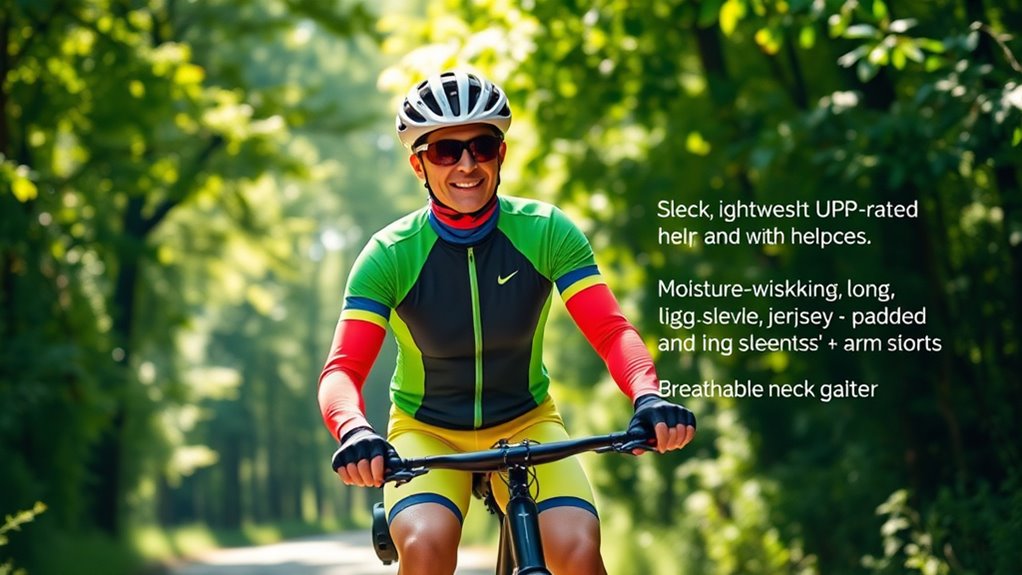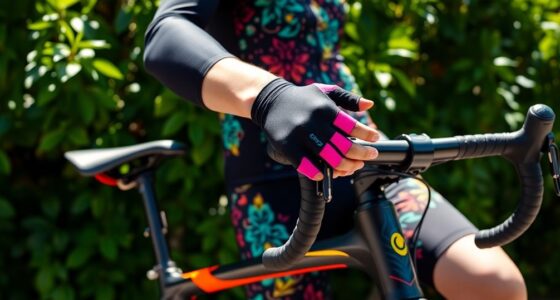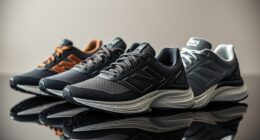Wearing UPF clothing while biking is one of the best ways to protect your skin and eyes from harmful UV rays. Look for garments with a UPF rating of at least 30, but ideally 50+, which block most UV radiation. Fabrics like polyester and nylon offer better protection, especially if they’re tightly woven or treated with UV inhibitors. Choosing the right clothing helps prevent sunburns and long-term damage, and if you keep exploring, you’ll find tips to stay safer under the sun.
Key Takeaways
- UPF-rated clothing offers effective UV protection, reducing the risk of skin damage during outdoor cycling.
- Fabrics with higher UPF (30 to 50+) block more UV rays, providing better sun safety while riding.
- Tightly woven synthetic fabrics like polyester and nylon typically offer superior UV protection.
- Combining UPF clothing with hats and sunglasses enhances overall sun safety on bike rides.
- Choosing lightweight, moisture-wicking UPF garments ensures comfort and protection in sunny cycling conditions.

Riding your bike under the sun can be enjoyable, but it also exposes your skin and eyes to harmful UV rays. That’s why protecting yourself is essential. One of the most effective ways to do this is through UV protection clothing. These specially designed garments help block out the sun’s rays, reducing your risk of skin damage and long-term health issues like skin cancer. But not all clothing provides the same level of protection, so understanding clothing materials is key to making smart choices.
When choosing UV protection clothing, look for fabrics with a high UPF rating. UPF stands for Ultraviolet Protection Factor, and it indicates how well a fabric shields you from UV rays. The higher the UPF number, the better the protection. For cycling, you want clothing with at least a UPF of 30, but UPF 50+ offers the best defense. These garments are often made from tightly woven fabrics that prevent UV rays from penetrating through the fibers. Some materials also incorporate special UV-blocking treatments to enhance their protective qualities.
Clothing materials are essential to UV protection because they determine how much UV radiation reaches your skin. Natural fibers like cotton tend to have lower UPF ratings unless they’re tightly woven or treated. On the other hand, synthetic fabrics like polyester and nylon are often better at blocking UV rays because they can be woven tightly and treated with UV-inhibiting coatings. Many brands now produce cycling apparel using these advanced fabrics, providing a lightweight, breathable, yet protective option for sunny rides. Fabric technology plays a significant role in the effectiveness of UV protection clothing.
Synthetic fabrics like polyester and nylon offer superior UV protection for cycling gear.
Additionally, some clothing materials are designed with moisture-wicking and quick-drying properties, which keep you comfortable during long rides. Breathability is necessary because it helps prevent overheating and sweating, which can make you more vulnerable to sunburn. Opting for lightweight, long-sleeve shirts made from UPF-rated fabrics can provide excellent coverage while still keeping you cool. Pairing these with UV-protective hats or caps and sunglasses completes your sun safety gear.
Ultimately, understanding clothing materials and their UV protection capabilities allows you to choose the right gear for your biking adventures. It’s a simple step that offers significant benefits—protecting your skin from harmful rays, preventing burns, and reducing your long-term health risks. By investing in quality UPF clothing made from appropriate materials, you can enjoy your ride without constantly worrying about sun damage. Remember, staying protected isn’t just about sunscreen; your clothing plays an important role in keeping you safe while you hit the trails or roads under the bright sun.
Frequently Asked Questions
How Does UPF Clothing Compare to Sunscreen in Sun Protection?
UPF clothing provides continuous sun protection, unlike sunscreen, which needs regular reapplication. UPF fabric durability guarantees your gear blocks UV rays effectively over time, making it a reliable choice for outdoor activities. While sunscreen can be easily washed off or sweat away, UPF clothing offers consistent coverage, reducing your risk of sun damage without the hassle of frequent reapplication. Both work well together, but UPF gear gives you steady protection on long rides.
Can UPF Clothing Be Worn During Winter Cycling?
Absolutely, you can wear UPF clothing during winter cycling. Imagine layering up with durable fabrics that shield you from UV rays even on chilly days. As you brave the winter roads, UPF gear offers reliable protection without sacrificing breathability. Its fabric durability ensures it withstands harsh conditions, making it a smart choice. Don’t underestimate the power of winter layering—your skin stays protected, no matter the season.
Are UPF Fabrics Breathable Enough for Intense Rides?
Yes, UPF fabrics are breathable enough for intense rides. They’re designed with fabric breathability in mind, allowing air to circulate and keep you cool. Plus, their moisture-wicking properties help draw sweat away from your skin, preventing chafing and discomfort during exertion. So, you stay protected from UV rays without sacrificing comfort or performance, making UPF clothing a smart choice for vigorous cycling sessions.
How Often Should UPF Clothing Be Replaced?
You should replace your UPF clothing every couple of years, or sooner if it’s seen better days—because even superhero fabrics have their limits. The UPF fabric longevity depends on factors like washing, sun exposure, and wear. Keep an eye out for thinning, fading, or holes, which signal it’s time for a replacement. Remember, safe sun protection is worth keeping fresh, just like your favorite cycling gear!
Is UPF Clothing Eco-Friendly and Sustainably Produced?
Yes, UPF clothing can be eco-friendly and sustainably produced. Look for options made from eco-friendly fabrics like recycled polyester or organic cotton, which reduce environmental impact. Brands that prioritize sustainable manufacturing use eco-conscious dyes and fair labor practices, ensuring your sun protection gear aligns with your eco-values. By choosing these options, you support a healthier planet while staying protected from UV rays during your bike rides.
Conclusion
Staying safe under the sun while biking is within your grasp with the right UPF clothing. It’s a small investment that pays off in the long run, helping you avoid burns and skin damage. Remember, prevention is better than cure, so don’t wait until the sun’s blazing to act. Gear up properly, stay protected, and enjoy your ride without letting the weather put a damper on your adventure. After all, forewarned is forearmed.









